Need a Qwilr alternative?
Qwilr has been around since 2014 and is easily one of the most unique proposal software platforms on the market.
Currently, Qwilr offers the following key features:
- Proposals created and published as web pages.
- Legally binding electronic signatures.
- Dynamic pricing tables.
- Embeddable content.
- CRM and payment integrations.
- Document management tools.
Overall, it’s a great collection of features and Qwilr’s approach to build proposals as an interactive web page is still something that you won’t find anywhere else on the market.
However, Qwilr’s approach isn’t right for everyone.
Whether the proposal-as-a-web-page solution to document creation doesn’t fit with your team or you’re looking for more control over your layouts and setup, there are other options out there.
Let’s take a closer look at a few Qwilr alternatives, what they have to offer, and where they might stand out.
Quick note: Generally, we view RFP response solutions like RFPIO and Loopio as a separate category for proposal software, so we’ve excluded them from this list.
Key takeaways
- Qwilr excels at creating visually stunning proposals, and it’s the only platform that displays proposals as a true web page.
- Qwilr’s engagement analytics provide valuable insights. Other platforms can do this, too, but Qwilr’s reporting interface and capabilities are particularly user-friendly.
- Qwilr’s pricing may be prohibitive for smaller teams. While the Business plan ($35) offers strong features, Salesforce and custom domains are restricted to the Enterprise plan ($59), which requires a 5-seat minimum.
1. PandaDoc
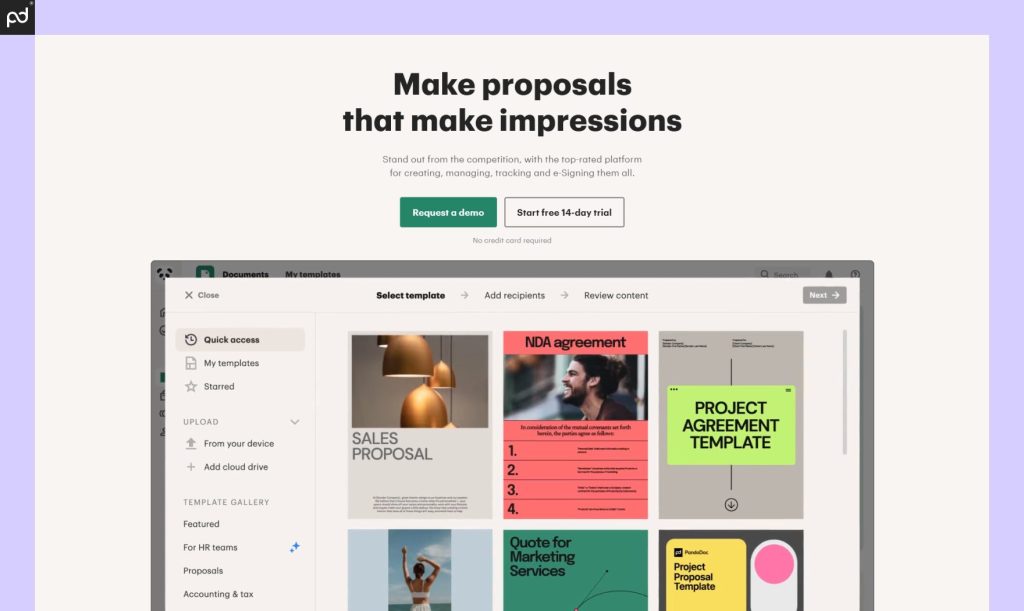
PandaDoc features end-to-end document creation, no-limit e-signing, and robust integration options.
Great fit for: PandaDoc is great for businesses and teams who want to automate and scale their document workflow.
Rating: PandaDoc is rated 4.7 of 5 stars on G2 with 2,500+ ratings.
Pricing: PandaDoc is charged at $19/month for Essentials and $49/month for Business. Enterprise plans are also available.
Free trial? PandaDoc offers a free 14-day trial.
While we might be slightly biased, PandaDoc stands out as a compelling alternative to Qwilr.
The platform offers a comprehensive, real-time solution for creating and managing documents, and its extensive integration library includes popular CRMs like HubSpot and Salesforce.
However, PandaDoc is more than a proposal management software. Beyond business proposals, PandaDoc caters to a wide range of documentation, including contracts, invoices, and various sales collateral. All documents can be created from scratch or kickstarted via a template from the PandaDoc template library.
You’ll also find plenty of tools to assist with contract lifecycle management. Small businesses and sales teams will find the approval workflows, contract dashboards, and document tracking helpful during follow-up — particularly when pushing to close deals.
This collection of features makes PandaDoc a powerful platform for any CPQ (configure, price, quote) process.
| Feature | Qwilr | PandaDoc |
|---|---|---|
| Proposal tools | Drag & drop | Drag & drop |
| Form generation | Limited | ✓ |
| E-signing | ✓ | ✓ |
| Templates | ✓ | ✓ |
| Content library | ✓ | ✓ |
| Custom domain | ✓ | X |
| Custom branding | ✓ | ✓ |
| Payment gateways | ✓ | ✓ |
| CRM integrations | 4 | 15+ |
| Document analytics | ✓ | ✓ |
| API access | $ | $ |
| Customer Support | ||
| Email / ticketing | ✓ | ✓ |
| 24/7 chat | $ | ✓ |
| Phone | X | $ |
| Success manager | $ | $ |
| Onboarding services | $ | $ |
Major differences
- PandaDoc offers a wider range of document types and use cases compared to Qwilr.
- Qwilr’s Form generation is limited to its accept / e-signing block while PandaDoc Forms offer more comprehensive outputs.
- PandaDoc offers a more extensive collection of integrations and templates than Qwilr.
Qwilr vs PandaDoc
Qwilr and PandaDoc are both powerful tools for creating and managing business documents, but they cater to different needs and preferences.
Qwilr shines in crafting visually stunning, interactive web pages that leave a lasting impression on clients. Its intuitive drag-and-drop editor and emphasis on design make it a top choice for businesses prioritizing aesthetics and engagement.
However, the web-based element that makes Qwilr so unique is also the component that limits its capabilities.
At the end of the day, Qwilr is designed around making landing pages that double as proposals. The platform lacks the ability to extend those design tools into other forms, layouts, and document types.
Users won’t be able to create sales enablement documentation or sales collateral with Qwilr. Contracts, invoices, quotes, and other business documents are largely out of the question.
In PandaDoc, all that (and more) is possible.
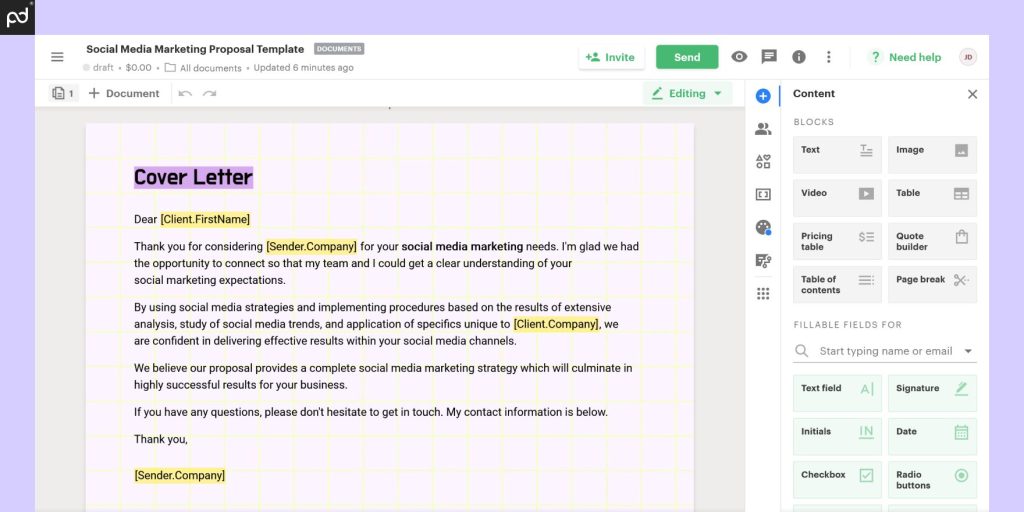
Overall, PandaDoc offers a more comprehensive solution for document creation and document management.
While PandaDoc won’t produce landing pages like Qwilr, the onboard document editor is built around the use of standard US Letter and US Legal page sizes.
This means that traditional documents can easily be built and deployed from within PandaDoc.
Notably, Qwilr documents can be downloaded as PDFs — but that isn’t the intended purpose of the platform.
Because of that, Qwilr PDFs aren’t shaped or sized with those layouts in mind and its ability to conform to standardized formats is limited.
While those restrictions hardly matter for online proposals, they matter greatly for text-heavy documents like contracts.
Beyond those key differences, PandaDoc also offers a greater selection of integrations.
This includes multiple payment gateways — Stripe, Paypal, Quickbooks, etc. — as well as a healthy selection of productivity integrations like Slack and Google Workspace.
Lastly, PandaDoc Forms are far more versatile than the forms available on Qwilr.
Forms created with PandaDoc are standalone items that can be embedded into web pages or accessed via a direct link.
Form responses are consolidated into a downloadable CSV file for easy collation.
With Qwilr, forms are locked behind the onboard Accept block.
Users who click on this block can enter additional information, which is then accessed via Qwilr’s onboard audit trail.
Unfortunately, this approach limits the effectiveness of forms due to its design lack of data consolidation.
2. Proposify
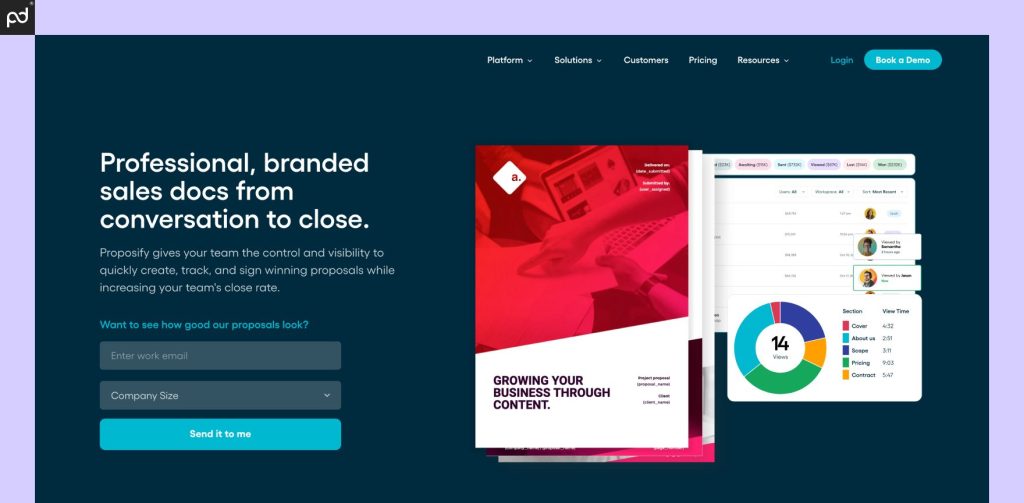
Proposify combines flexible proposal creation with granular control over document creation.
Great fit for: Sales and marketing teams who want granular control over proposal layouts and designs.
Rating: Proposify is currently rated 4.6 of 5 stars on G2 with 1,000+ ratings.
Pricing: Proposify is charged at $29/month for Basic, $41/month for Team, and $650/month for Business (10-seat minimum).
Free trial? Proposify offers a 14-day trial.
Proposify is a formidable contender in the proposal software landscape.
This platform specializes in crafting and managing proposals that are both visually captivating and highly effective.
Like PandaDoc and Qwilr, Proposify leverages a drag-and-drop editor to assist in document creation.
However, when compared to other design tools, Proposify’s editor is far more granular.
Sales reps with a design background will feel at home inside this software and will be able to craft impressive proposals within the platform.
Proposify also offers a modest selection of integrations, as well as document tracking and analytics tools to help teams identify bottlenecks and optimize proposal engagement.
At the end of the day, Proposify’s core focus is on proposals, and this platform excels at providing a holistic solution for teams who want to stand out from the crowd.
| Feature | Qwilr | Proposify |
|---|---|---|
| Proposal tools | Drag & drop | Drag & drop |
| Form generation | Limited | Limited |
| E-signing | ✓ | ✓ |
| Templates | ✓ | ✓ |
| Content library | ✓ | ✓ |
| Custom domain | ✓ | ✓ |
| Custom branding | ✓ | ✓ |
| Payment gateways | ✓ | Limited |
| CRM integrations | 4 | 2 |
| Document analytics | ✓ | ✓ |
| API access | $ | X |
| Customer Support | ||
| Email / ticketing | ✓ | ✓ |
| 24/7 chat | $ | X |
| Phone | X | $ |
| Success manager | $ | $ |
| Onboarding services | $ | $ |
Major differences
- Similar to PandaDoc, the Proposify editor is built around the constraints of a sheet of paper rather than a web page.
- Overall, Proposify offers more precise control over the look and feel of its outputs than the Qwilr editor.
- In terms of integrations, Proposify offers fewer connectors to CRMs, payment gateways, and productivity solutions.
Qwilr vs Proposify
Qwilr and Proposify are both formidable contenders in the proposal software arena, each with its own strengths and unique approaches.
(We regularly highlight Qwilr as an alternative to Proposify for this reason.)
One of the most striking things about Qwilr is its ease of use and setup.
During the registration process, users will set business names, brand colors, and upload logos.
From there, Qwilr automatically creates a selection of branded content blocks built from that information.
While this is adjustable, it gives users a fast and easy way to make their proposal match their brand design.
That, combined with a prebuilt library of content blocks (as well as a simple way to create new blocks) further simplifies the Qwilr design process.
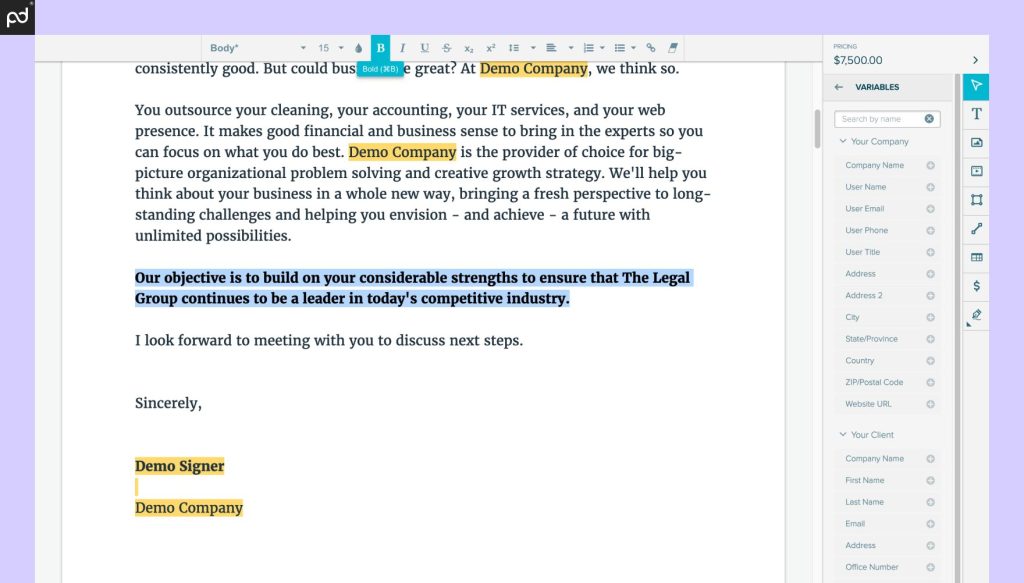
With Proposify, users have more control at the cost of a much higher learning curve.
Designs can be ultra-precise, but users will need to have a greater understanding of the layout process, how elements snap together, and what changes need to be made in order to achieve results.
Proposify helps with this by providing a sizable collection of templates, but the onboarding process is slower than what users will experience with most other platforms.
One notable issue that both platforms share is the inability to import existing documentation into the platform.
With PandaDoc, it’s possible to import and convert Word files into new documents or templates. With both Qwilr and Proposify, teams will need to recreate any documents from scratch inside the editor.
Both platforms will allow a form of embedding, where you can add your files as an attachment to the proposal document — but those documents can’t be edited or modified when uploaded in that way.
The best choice between Proposify and Qwilr will depend on your business needs.
If web-based sales proposals are a great fit for your team, Qwilr may work well.
However, as with PandaDoc, Proposify documents are built around the constraints of a sheet of paper.
That approach gives far more flexibility in terms of printable outputs and standardized documents.
3. DocSend
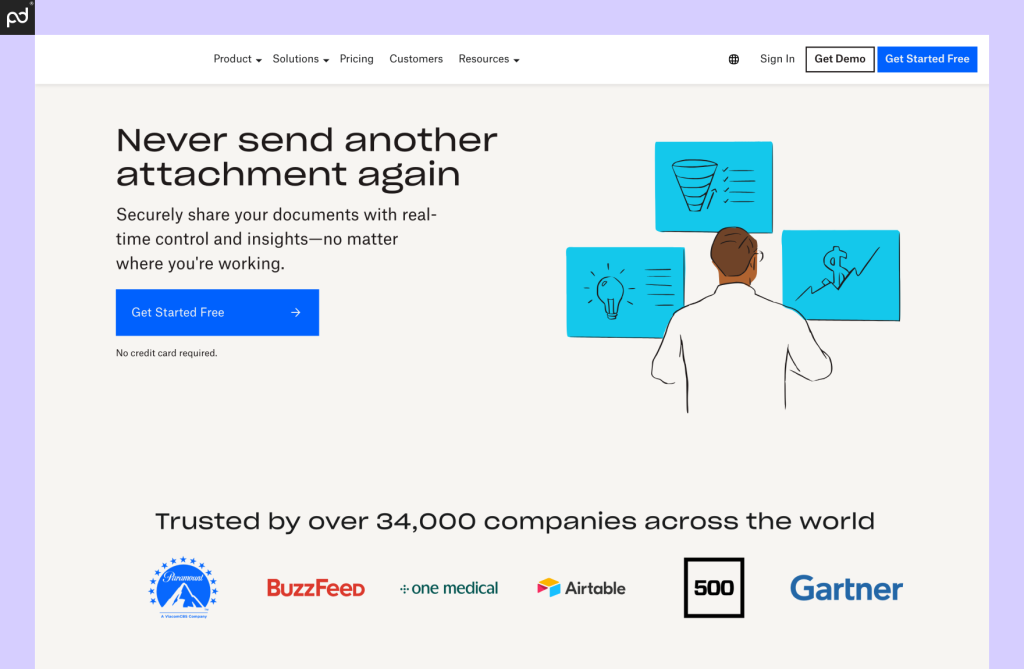
DocSend offers secure document sharing and in-depth analytics for tracking viewer engagement.
Great fit for: Teams who are more focused on securely sharing documents and don’t need live editing tools.
Rating: DocSend is rated 4.6 of 5 stars on G2 with 500+ ratings.
Pricing: DocSend is charged at $15/month for the Personal plan, $65/month for the Standard plan, $250/month for the Advanced plan, and $300/month for the Advanced Data Rooms plan.
Free trial: DocSend offers a free 14-day trial.
DocSend is a powerful tool designed for secure document sharing and in-depth analytics, catering to sales teams, investors, and businesses seeking to optimize document engagement.
Unlike traditional proposal software, DocSend focuses on providing a secure environment for sharing confidential materials and gaining valuable insights into recipient interactions.
This is vastly different from some of the other Qwilr alternatives we’ve covered thus far since DocSend offers no document editor.
Instead, the platform is purely focused on the project management and permissions aspects of document sharing and distribution.
Users can track who views their documents, receive notifications about usage, monitor time spent on each page, and more.
Using this data, sales teams can tailor their follow-up strategies, identify potential roadblocks, and aim to close deals more effectively.
While not a full-fledged proposal creation platform like Qwilr or Proposify, DocSend’s strength lies in its secure sharing, detailed analytics, and seamless integrations.
This makes it an attractive option for businesses prioritizing data-driven decision-making and a secure environment for sensitive documents.
| Feature | Qwilr | DocSend |
|---|---|---|
| Proposal tools | Drag & drop | X |
| Form generation | Limited | X |
| E-signing | ✓ | ✓ |
| Templates | ✓ | X |
| Content library | ✓ | X |
| Custom domain | ✓ | ✓ |
| Custom branding | ✓ | ✓ |
| Payment gateways | ✓ | X |
| CRM integrations | 4 | 1 |
| Document analytics | ✓ | ✓ |
| API access | $ | X |
| Customer Support | ||
| Email / ticketing | ✓ | ✓ |
| 24/7 chat | $ | Limited |
| Phone | X | ✓ |
| Success manager | $ | X |
| Onboarding services | $ | X |
Major differences
- DocSend doesn’t offer any kind of document creation toolkit. You won’t find a document editor or content library here.
- Both Qwilr and DocSend allow for the use of custom domains, making it possible to mask the services as an extension of your business website.
- Overall, DocSend’s tracking and analytics are superior to what Qwilr and most other platforms will provide.
Qwilr vs DocSend
Qwilr and DocSend offer distinct approaches to document management, each with its own strengths and target audience.
With Qwilr, users can create visually stunning and interactive proposals via its drag-and-drop editor, content library, and extensive customization options.
These tools enable businesses to craft compelling web pages that captivate clients and leave a lasting impression.
On top of that, Qwilr offers some extendibility with payment processing and CRM integrations. All web pages even have embedded analytics so that teams can better understand how viewers interact with specific documents.
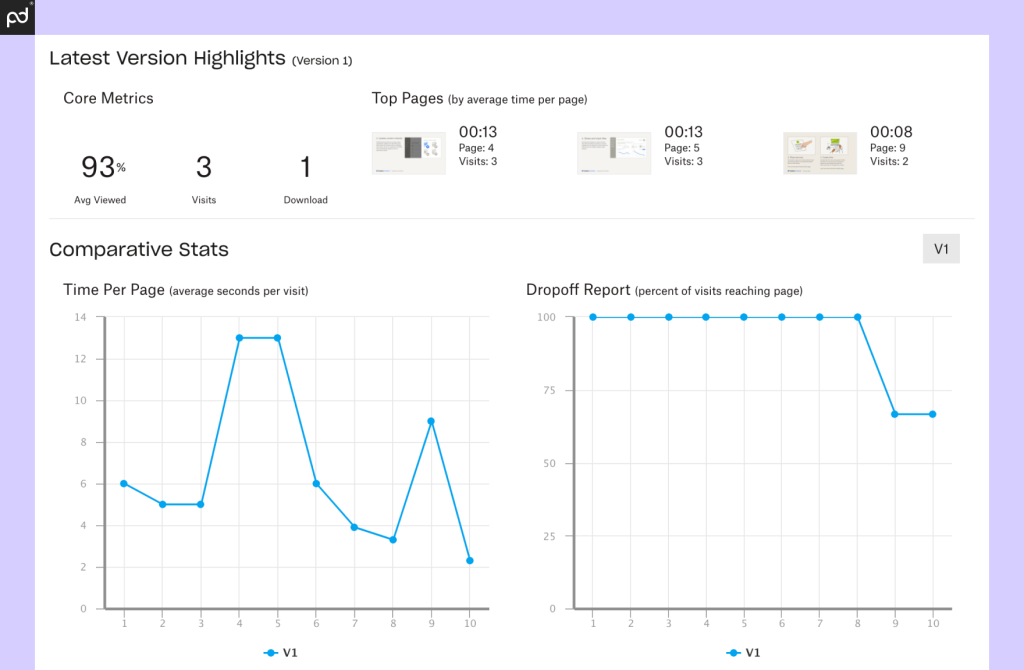
On the other hand, DocSend centers around secure document sharing and in-depth analytics during the sending process.
It’s possible to send any type of document with DocSend — not just proposals.
This gives the platform an added versatility that can’t be replicated inside of Qwilr due to the platform’s proposal-aligned focus.
DocSend’s strength lies in its ability to provide a secure environment for sharing confidential materials and gaining valuable insights into recipient interactions.
This includes detailed tracking for views, time spent, and specific sections of interest.
The downside is that, because DocSend is built as a sending platform, it doesn’t support any type of document creation toolkit.
All files sent with DocSend will need to be built elsewhere — likely in a word processor or similar offline tool.
If you’re looking for a tool that combines robust document analytics with proposal creation, PandaDoc may be a compelling alternative.
The ability to handle (and create!) a variety of document types, provide detailed analytics, and integrate seamlessly with your tech stack means that you won’t have to choose between great design and powerful insights.
4. Prospero
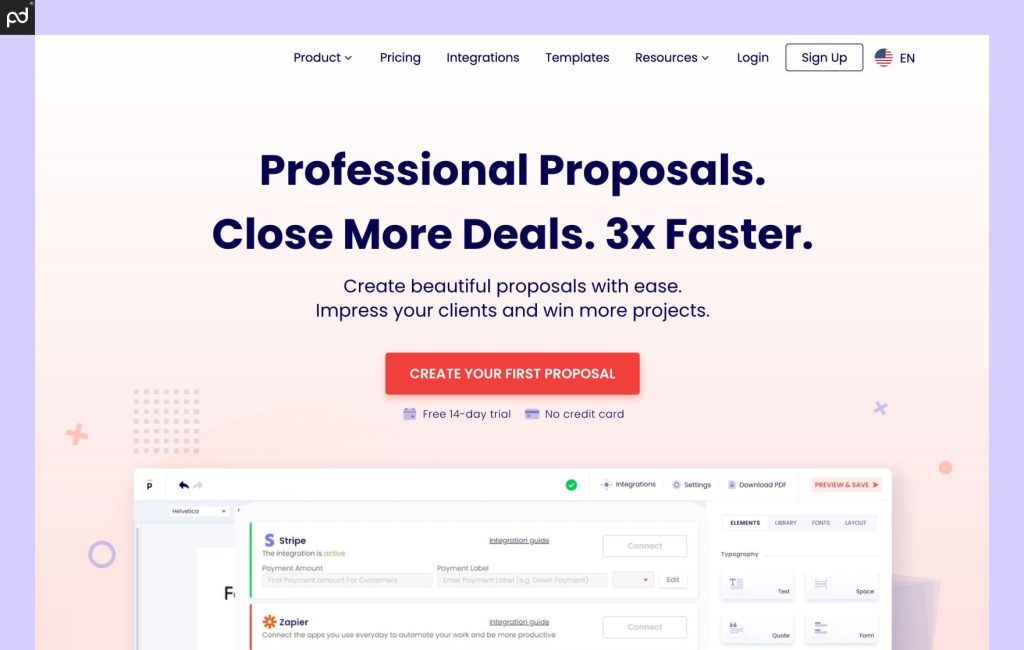
Prospero emphasizes simplicity, ease of use, and affordability for freelancers and small businesses.
Great fit for: Freelancers and small teams who don’t want to spend a ton of time on proposal design.
Rating: Prospero is rated 5 of 5 stars on G2 with 5+ ratings.
Pricing: Prospero is charged at $8/month per user.
Free trial: Prospero offers a free 14-day trial.
Prospero is a great tool for freelancers, agencies, and small businesses who want to create professional-looking proposals without the fuss.
The platform provides a simple and easy-to-use interface with semi-customizable components. Using these tools, teams can create polished proposals at speed and without needing to spend extra time on layout and design.
While Prospero lacks some of the features seen in competitors, the platform is heavily focused on providing a turnkey solution that gets the job done quickly and efficiently.
This makes it a great choice for teams who prefer simplicity and ease of use. Plus, it’s budget-friendly pricing makes it a great choice for smaller teams.
| Feature | Qwilr | Prospero |
|---|---|---|
| Proposal tools | Drag & drop | Drag & drop |
| Form generation | Limited | Limited |
| E-signing | ✓ | ✓ |
| Templates | ✓ | ✓ |
| Content library | ✓ | ✓ |
| Custom domain | ✓ | X |
| Custom branding | ✓ | X |
| Payment gateways | ✓ | ✓ |
| CRM integrations | 4 | X |
| Document analytics | ✓ | ✓ |
| API access | $ | X |
| Customer Support | ||
| Email / ticketing | ✓ | X |
| 24/7 chat | $ | Limited |
| Phone | X | X |
| Success manager | $ | X |
| Onboarding services | $ | X |
Major differences
- Prospero offers proposal creation but designs are similar and follow a pre-built structure.
- Expect limited integrations and extendibility with Prospero, especially when compared to Qwilr and other high-end proposal solutions.
- Overall, Prosper is considerably more cost effective than Qwilr, coming in at $8/user on an annual plan.
Qwilr vs Prospero
While Qwilr and Prospero are both great options for creating proposals, they each cater to different needs.
Qwilr is built around web-based design, and it comes with all the tools you need to build stunning proposals in that medium.
Most notably, when compared to Prospero, Qwilr offers unparalleled flexibility in its formatting and layouts.
Users can design pages with a look and feel that makes sense for the brand and conveys the information in a variety of interesting ways.
Custom branding and linking options also mean that it’s possible to create a seamless experience with Qwilr.
Pages can be made to look like extensions of your business domain, and Qwilr’s branding solutions give every proposal a top-notch presentation.
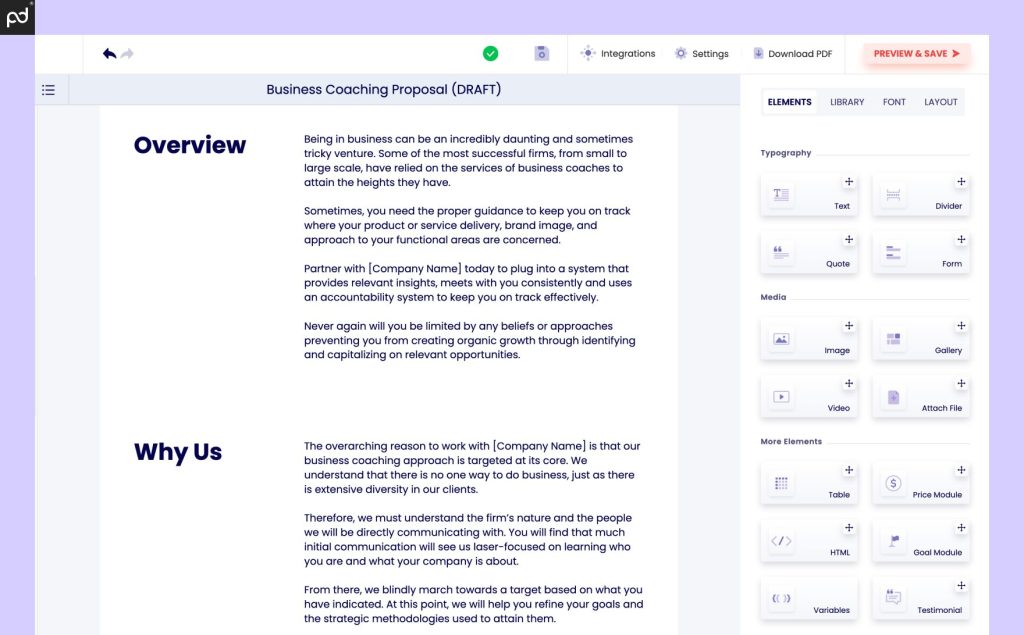
Prospero is a more straightforward proposal solution.
It’s easy to use and follows a pre-built format that makes proposal outputs look largely the same.
This is a big difference from Qwilr, which provides more open-ended formatting solutions and layouts.
Whether or not Prospero’s proposal layouts work for users is largely a matter of taste.
Proposal design only follows strict guidelines in specific circumstances, such as RFP requests or grant proposals, and neither Qwilr nor Prospero are a good fit for those needs.
Beyond proposal design, Prospero offers limited extendibility.
The platform provides a payment gateway via Stripe, an e-signature solution, and a few integration options — but the platform’s emphasis is on speed more than anything else.
Like PandaDoc and Proposify, the platform is built around the constraints of a printed page. However, Prospero lacks the ability to create truly diverse proposals that stand out from the crowd.
For that, you’ll need a more robust proposal solution.
5. GetAccept
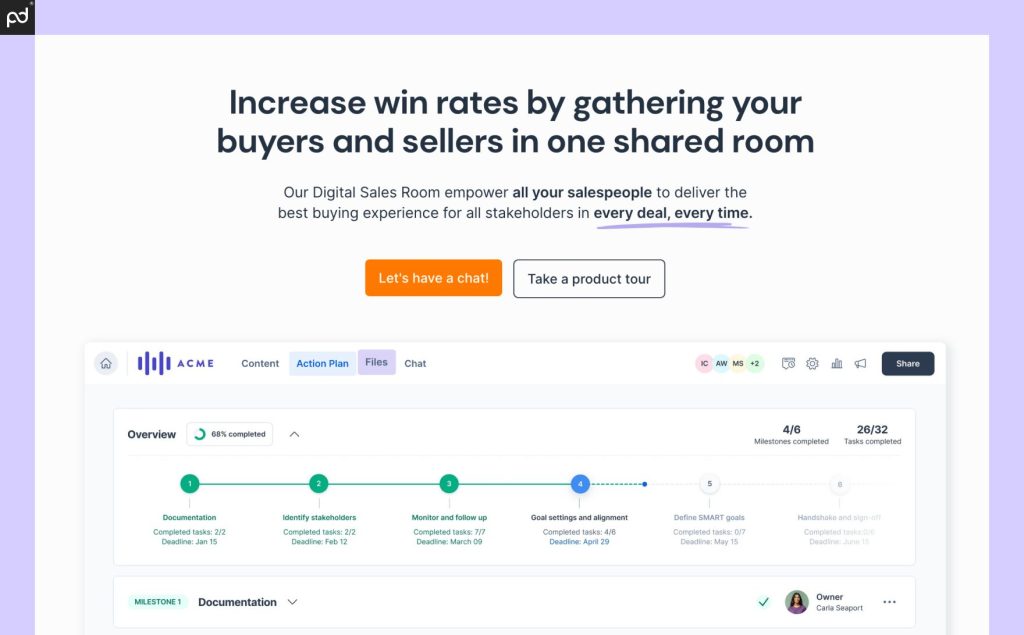
GetAccept combines proposals, contracts, and payments into one platform with real-time engagement tracking.
Great fit for: Teams looking for software tools to manage their end-to-end sales process.
Rating: GetAccept is rated 4.6 of 5 stars on G2 with 850+ ratings.
Pricing: GetAccept is charged at $25/month for eSign, $39/month for Deal Room, $49/month for Contract Room, and $79/month for Full Suite. Enterprise pricing is also available.
Free trial: GetAccept offers a free 14-day trial.
GetAccept is a sales platform built around empowering sales teams and closing deals.
Users gain access to a set of tools to engage stakeholders and drive deals steadily toward close.
Unlike most other tools on our list, proposal creation and document generation are secondary objectives with GetAccept.
Teams will have that capability, but GetAccept considers that documentation as only one aspect of a much greater whole.
With that in mind, teams will also gain access to deal rooms, collaborative engagement tools, and more.
The entire suite is built to help open communication between teams in order to clarify details, negotiate contracts, and close deals in record time.
| Feature | Qwilr | GetAccept |
|---|---|---|
| Proposal tools | Drag & drop | Drag & drop |
| Form generation | Limited | Limited |
| E-signing | ✓ | ✓ |
| Templates | ✓ | ✓ |
| Content library | ✓ | ✓ |
| Custom domain | ✓ | X |
| Custom branding | ✓ | ✓ |
| Payment gateways | ✓ | $ |
| CRM integrations | 4 | 5 |
| Document analytics | ✓ | ✓ |
| API access | $ | $ |
| Customer Support | ||
| Email / ticketing | ✓ | ✓ |
| 24/7 chat | $ | ✓ |
| Phone | X | X |
| Success manager | $ | $ |
| Onboarding services | $ | X |
Major differences
- Qwilr’s proposal design tools offer more flexibility and customization than GetAccept.
- GetAccept offers a wide range of sales tools and services that extend beyond proposal creation.
- GetAccept offers more plan customization options but also carries more add-ons, which can increase total costs.
Qwilr vs GetAccept
GetAccept is less about proposal creation and more about getting deals done.
The entire platform is designed as a sales tool to help teams push deals toward close. (Check out the full review here.)
That’s important, because that mindset allows this platform to stand apart from Qwilr and other competitors in a few specific ways.
Although Qwilr offers a powerful design solution for proposals, the platform isn’t terribly concerned with how you handle the remainder of your negotiation.
Qwilr users will need to have their own sales pipeline that they use to track and maintain deal status independently of their document design.
The platform will give users the tools they need to create proposals that fit the deal in progress, but managing the customer relationship and any aspects outside of those dealing with documentation aren’t factors that Qwilr is equipped to handle.
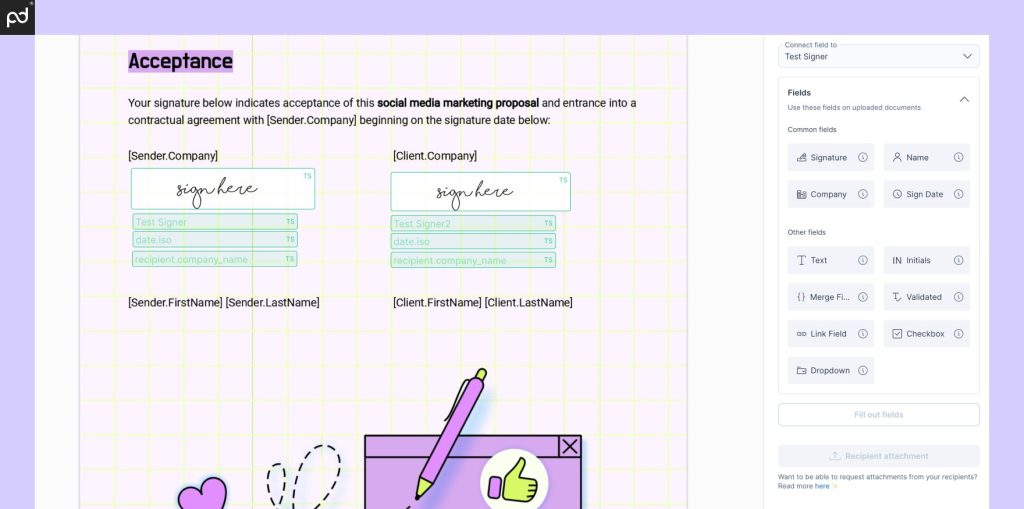
GetAccept takes a different approach.
The platform is designed primarily around sales enablement and document creation.
With GetAccept, users will have the ability to manage most aspects of the CPQ process and combine any documentation with tools that encourage collaboration and client communication.
Although GetAccept isn’t a substitute for a dedicated pipeline tool or CRM platform, it’s possible to offload all document creation responsibilities into GetAccept from those tools and then use the onboard collaboration features to keep everything in one place until deals are finalized.
PandaDoc takes a similar approach with features like our Salesforce integration.
Teams manage customer accounts and outreach progression inside the CRM, then offload their CLM progress into PandaDoc.
Once the deal is finalized and contracts are signed, everything hands off seamlessly back to Salesforce, where deals are logged within the main CRM.
Qwilr offers some functionality around this with its collaborative editing tools and live chat integrations, but GetAccept offers a greater suite of tools built specifically for this purpose.
In exchange, GetAccept’s proposal tools aren’t as robust as Qwilr and often feel very rudimentary by comparison.
While GetAccept won’t create web pages, it does allow for embeddable content and more robust form generation.
Choosing between these two platforms will come down to what selection of features makes the most sense for your business operation.
6. Nusii
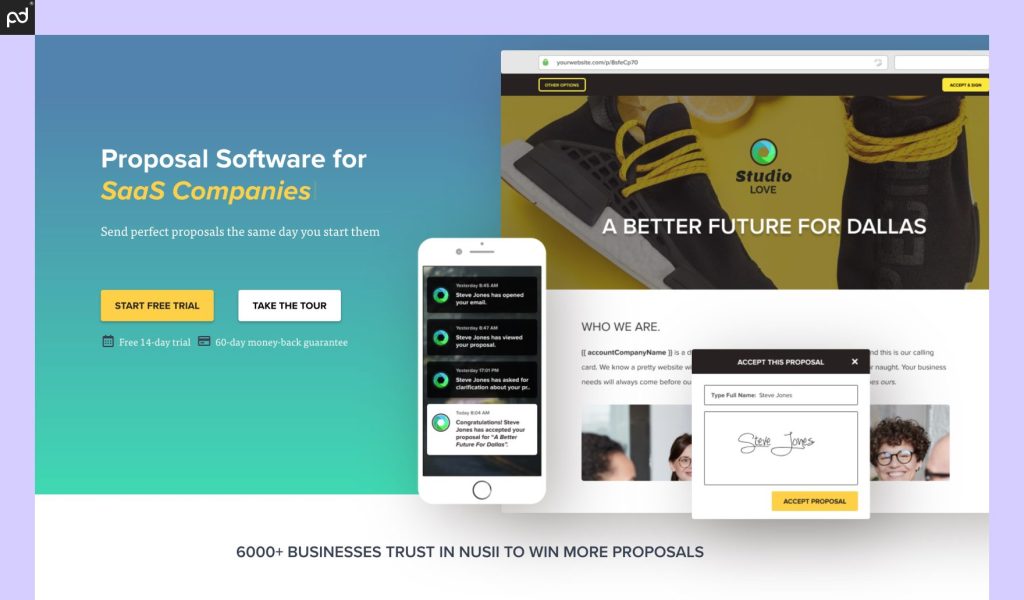
Nusii is focused on beautiful design, a seamless client experience, and turnkey proposal creation.
Great fit for: Teams looking for streamlined proposals that are both easy to build and easy to read.
Rating: Nusii is rated 4.5 of 5 stars on G2 with 20+ ratings.
Pricing: Nusii is charged at $29/month for Freelance, $49/month for Agency, and $129/month for Business.
Free trial: Nusii offers a free 14-day trial.
Nusii is a proposal software designed for freelancers and teams who value beautiful design and a seamless client experience.
The platform’s strength lies in its ability to create proposals that fit a brand’s unique style without spending hours in formatting and design.
Nusii features a drag-and-drop editor, customizable templates, and extensive formatting options, making it easy to create professional-looking proposals that stand out.
Beyond its design tools, Nusii offers essential features like online payment acceptance, client feedback tools, and proposal analytics.
It also integrates with popular CRMs and project management tools, streamlining your workflow and keeping your client interactions organized.
Though Nusii may not have the same breadth of features as some other platforms, its focus on design and client experience makes it a compelling quoting tool for those who prioritize aesthetics and ease of use.
| Feature | Qwilr | Nusii |
|---|---|---|
| Proposal tools | Drag & drop | Drag & drop |
| Form generation | Limited | X |
| E-signing | ✓ | ✓ |
| Templates | ✓ | ✓ |
| Content library | ✓ | ✓ |
| Custom domain | ✓ | ✓ |
| Custom branding | ✓ | ✓ |
| Payment gateways | ✓ | ✓ |
| CRM integrations | 4 | 4 |
| Document analytics | ✓ | ✓ |
| API access | $ | ✓ |
| Customer Support | ||
| Email / ticketing | ✓ | ✓ |
| 24/7 chat | $ | X |
| Phone | X | X |
| Success manager | $ | X |
| Onboarding services | $ | X |
Major differences
- Nusii templates are pre-structured, meaning that users only have to worry about adding content rather than formatting blocks and managing layouts.
- Overall, Nusii is focused on small- to medium-sized businesses, but the platform can scale with additional users.
- Qwilr offers more comprehensive analytics and more flexible layouts, but it also requires a better sense of design and proposal composition.
Qwilr vs Nusii
Nusii and Qwilr are both very similar and very different at the same time.
With Nusii, users will transition away from the website design tools offered by Qwilr, but not by much.
Similar to Qwilr, Nusii’s layouts are primarily designed and displayed as web pages.
The platform allows users to redirect to a custom domain when displaying their proposal content, so — like Qwilr — a Nusii proposal can act like an extension of a regular business website.
Nusii also provides a suite of features similar to Qwilr.
Both platforms have e-signing capabilities, template libraries, interactive pricing tables, and payment capture.
However, the two platforms stand apart from one another where designs, layouts, and formatting are concerned.
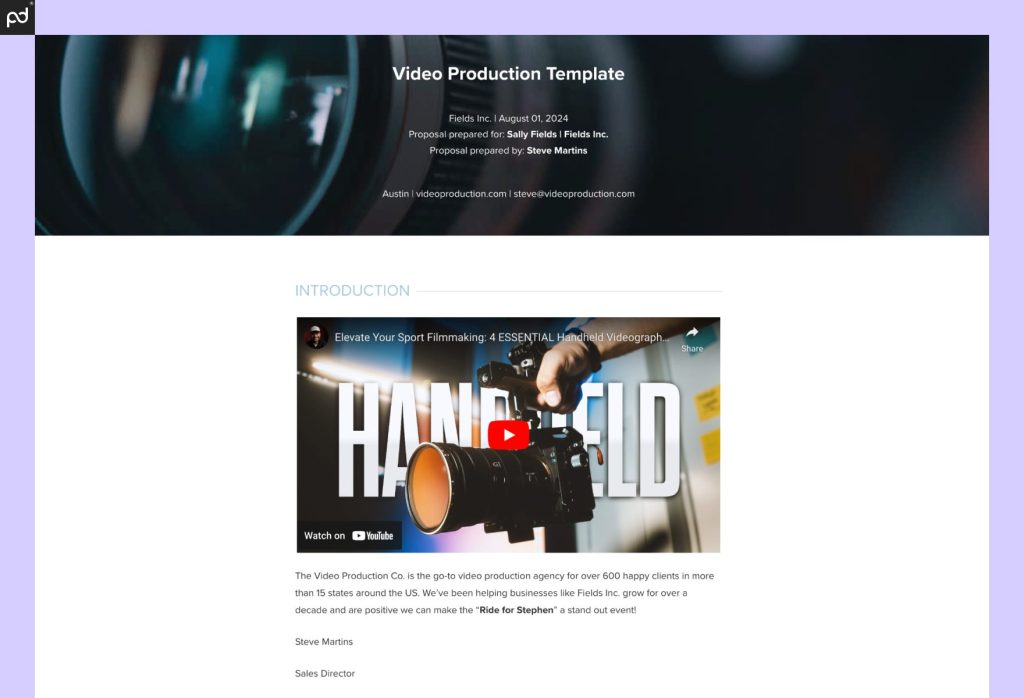
Compared to Qwilr, Nusii layouts are far more structured.
Qwilr often incorporates various elements from web design like columns, dropdowns, and accordions, into its layout structure.
This gives users added flexibility during the design process and makes the page more closely resemble a true web page.
By contrast, Nusii opts instead for a no-frills layout.
Text and images are contained to the center of the page and are only broken up by headers and tables.
While this approach produces clean outputs and minimizes the time spent in design, it also means that most Nusii proposals look similar to one another.
Ultimately, teams that prefer more control over design will likely prefer Qwilr, Proposify, or PandaDoc.
However, for those who want a solution that still passes for a landing page like Qwilr (even if it lacks the same level of control), Nusii may be a good choice.
7. DealHub

DealHub provides robust CPQ (Configure, Price, Quote) capabilities for complex sales processes.
Great fit for: Organizations seeking tools to boost their selling process.
Rating: DealHub is rated 4.7 of 5 stars on G2 with 580+ ratings.
Pricing: DealHub pricing is custom-built by the in-house sales team.
Free trial: DealHub doesn’t offer a free trial.
DealHub is a full-scope sales engagement platform aimed at streamlining and optimizing the sales process.
Similar to GetAccept and other platforms, the ability to create and send proposals is only a small part of DealHub’s capabilities.
Users will also find a comprehensive suite of sales tools, including selling playbooks, deal rooms, subscription management, and much more.
Generally, DealHub aims to keep all conversations around a specific quote or proposal in one place.
The platform focuses on features that provide continuity to every proposal — from start to finish — so that your team can leverage a unified process for each and every prospective buyer.
| Feature | Qwilr | DealHub |
|---|---|---|
| Proposal tools | Drag & drop | Compiler |
| Form generation | Limited | X |
| E-signing | ✓ | ✓ |
| Templates | ✓ | ✓ |
| Content library | ✓ | ✓ |
| Custom domain | ✓ | X |
| Custom branding | ✓ | ✓ |
| Payment gateways | ✓ | ✓ |
| CRM integrations | 4 | 6 |
| Document analytics | ✓ | ✓ |
| API access | $ | ✓ |
| Customer Support | ||
| Email / ticketing | ✓ | ✓ |
| 24/7 chat | $ | X |
| Phone | X | ✓ |
| Success manager | $ | ✓ |
| Onboarding services | $ | ✓ |
Major differences
- DealHub offers a broad toolkit for use outside of sales and proposal creation.
- Although DealHub doesn’t list its price and customizes its usage based on the team, expect hiring pricing than any of Qwilr’s off-the-shelf plans.
- Qwilr offers more design options in the proposal process but less flexibility in tailoring its outputs to your overall sales flow.
Qwilr vs DealHub
While Qwilr and DealHub each have a place in the right sales flow, it’s unlikely that they will coexist alongside one another due to their overlapping use cases.
Qwilr is a great choice for teams who want to prioritize proposal design and client engagement. Its intuitive drag-and-drop editor, extensive template library, and powerful customization options makes proposal design fast and easy.
The platform offers interactive quotes and proposals that can leave a lasting impression and feel more nuanced than something created in Microsoft Word or Adobe InDesign.
You’ll also find a number of features that can streamline your sales process, including e-signatures and data analytics.
For smaller teams, what Qwilr offers is likely to be enough to handle this aspect of the sales process — particularly if this tool is integrated a CRM platform to keep track of customer profiles.
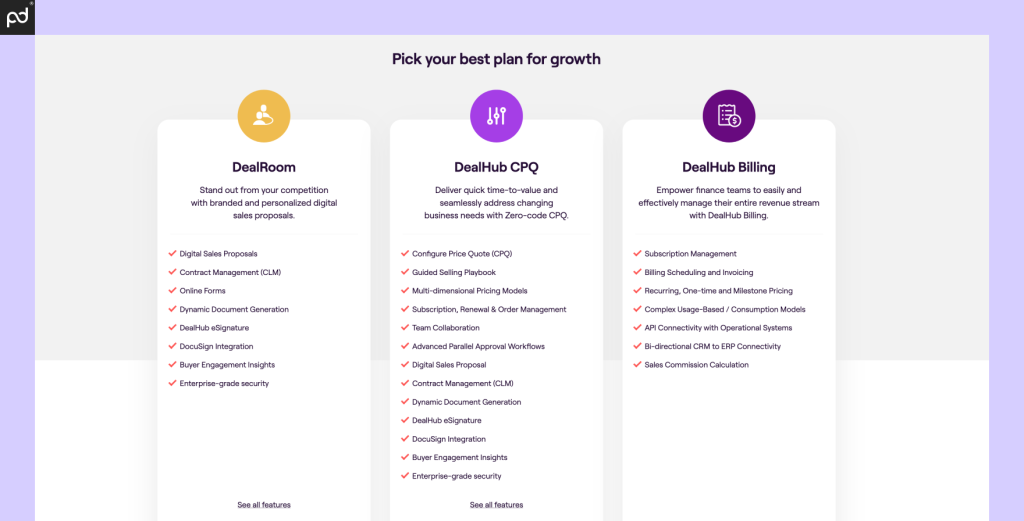
However, if you’re a larger organization with a complex sales process, DealHub may be the better choice.
The platform is a comprehensive sales enablement platform and comes equipped with a wide range of features and automations.
You’ll find a particular emphasis placed on subscription management, which is something that DealHub is known for outside of its sales flow and its focus on customer success.
Like Qwilr, DealHub offers some document generation tools.
However, while Qwilr provides an intuitive, drag-and-drop interface for proposal production, DealHub is a compiler. Users will add all of the necessary information (most of which can be predefined in a template), press a single button, and wait for the platform to generate a proposal.
It’s less hands-on, and the output is more of a turnkey solution.
Which method or approach you need will depend on what you value most in your sales flow. However, both platforms do offer ways to improve the sales process, close more deals, and earn more business.
8. Fresh Proposals

Fresh Proposals features user-friendly proposal creation tools, customizable templates, and great document analytics.
Great fit for: Teams looking for an online document builder who aren’t worried about sophisticated CRM integrations.
Rating: Fresh Proposals is rated 4.8 of 5 stars on G2 with 10+ ratings.
Pricing: Fresh Proposals is charged at $15/month for Starter, $30/month for Professional, and $59/month for Business.
Free trial: Fresh Proposals offers a free 14-day trial.
Fresh Proposals is a breeze to use, making it a great option for teams who want to create polished, professional proposals with minimal hassle.
The platform takes the pain out of proposal formatting and design so that your team can focus more on closing deals, collaborating with prospects, and moving revenue down the sales pipeline.
Similar to Qwilr and other options on this list, Fresh Proposals comes equipped with customizable templates, interactive pricing tables, electronic signatures tools, and more.
Plus, with built-in document analytics, you can see how your proposals are performing and use that to further optimize future documentation.
| Feature | Qwilr | Fresh Proposals |
|---|---|---|
| Proposal tools | Drag & drop | Drag & drop |
| Form generation | Limited | X |
| E-signing | ✓ | ✓ |
| Templates | ✓ | ✓ |
| Content library | ✓ | ✓ |
| Custom domain | ✓ | ✓ |
| Custom branding | ✓ | ✓ |
| Payment gateways | ✓ | ✓ |
| CRM integrations | 4 | 3 |
| Document analytics | ✓ | ✓ |
| API access | $ | X |
| Customer Support | ||
| Email / ticketing | ✓ | ✓ |
| 24/7 chat | $ | X |
| Phone | X | X |
| Success manager | $ | X |
| Onboarding services | $ | X |
Major differences
- While Qwilr emphasizes visually captivating proposals, Fresh Proposals is more focused on simplicity and ease of use.
- Overall, Fresh Proposals offers far fewer design and layout options than Qwilr.
- Fresh Proposals offers fewer integrations and more basic analytics options, but it’s less expensive.
Qwilr vs Fresh Proposals
Both of these platforms are solid options for proposal creation, but they emphasize different aspects of the creation process.
Qwilr users have the ability to design and create proposals entirely from scratch in a web-based environment.
You’ll find a wealth of interactive elements and multimedia options, all working together to create a web page that will catch the eye and impress visitors.
This is a vastly different approach when compared to Fresh Proposals, which offers many of the same tools but tends to provide them in a more simple and straightforward format.
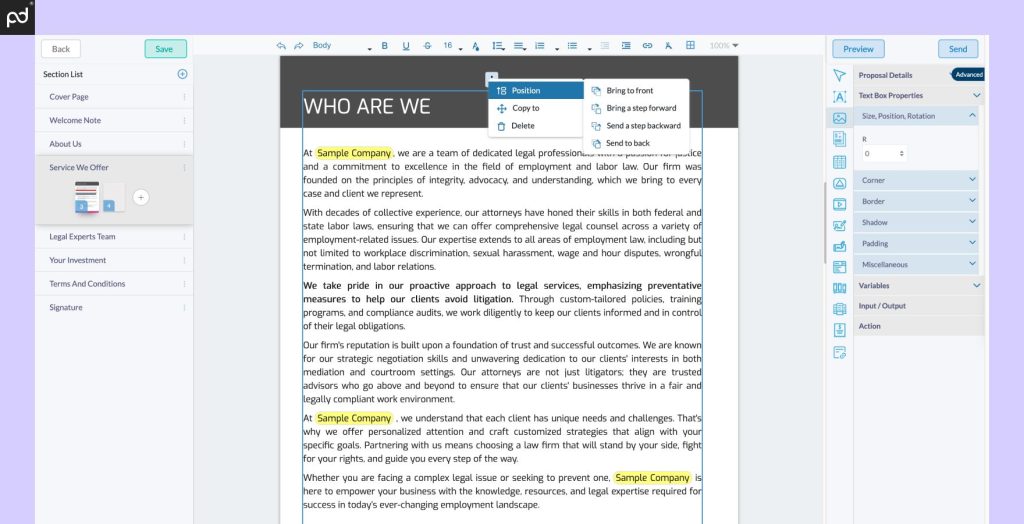
Similar to Nusii or Proposify, Fresh Proposals utilizes a drag-and-drop editor built around the idea of traditional, page-based proposals.
The platform offers an intuitive interface and easy-to-use templates, but it lacks some of the advanced features found in Qwilr.
The editor, while comprehensive, is also less refined than what you’ll find in PandaDoc, as many of the designs and layouts feel a bit dated — despite the web-based builder.
All that aside, Fresh Proposals is more than capable of getting the job done.
Its lower cost and onboard toolkit make it a great choice for freelancers and small businesses.
9. Ignition

Ignition acts as a client engagement and commerce platform for professional service businesses
Great fit for: Medium and larger organizations interested in turnkey document automation.
Rating: Ignition is rated 4.6 of 5 stars on G2 with 50+ ratings.
Pricing: Ignition is charged at $99/month for Core, $199/month for Pro, and $499 for Pro+.
Free trial: Ignition offers a free 14-day trial.
Ignition is a one-stop shop for professional service businesses, helping them streamline how they bring on new clients, create proposals, and handle payments.
By automating these tasks and keeping all client interactions in one place, Ignition helps businesses provide a smooth and professional experience from the moment a client signs on until the project wraps up.
With Ignition’s easy-to-use interface, you can whip up custom proposals, set payment plans, and keep tabs on project progress without breaking a sweat.
It’s all about making things more efficient and keeping clients happy, which allows users to focus more on growing the business and building stronger relationships.
| Feature | Qwilr | Ignition |
|---|---|---|
| Proposal tools | Drag & drop | Compiler |
| Form generation | Limited | X |
| E-signing | ✓ | Limited |
| Templates | ✓ | ✓ |
| Content library | ✓ | Limited |
| Custom domain | ✓ | X |
| Custom branding | ✓ | ✓ |
| Payment gateways | ✓ | ✓ |
| CRM integrations | 4 | 0 |
| Document analytics | ✓ | X |
| API access | $ | X |
| Customer Support | ||
| Email / ticketing | ✓ | ✓ |
| 24/7 chat | $ | X |
| Phone | X | X |
| Success manager | $ | X |
| Onboarding services | $ | ✓ |
Major differences
- Ignition is primarily aimed at professional service businesses while Qwilr fits businesses of all types.
- Qwilr offers a far more extensive design toolkit when compared to Ignition.
- Ignition emphasizes client onboards, engagement, and payment options while Qwilr is focused more on proposal design.
Qwilr vs Ignition
There’s a lot to love about both Qwilr and Ignition, as they each excel in specific areas of the client engagement process. However, depending on your sales process, one is likely to be a better fit than the other.
Qwilr shines in the proposal creation process.
Its proposals are sleek, eye-catching, and provide an ideal blend of modern technology, multimedia, and design aesthetic.
They’re perfect for teams who need to stand out from the crowd and captivate an audience.
If your goal is to create branded proposals that do all of those things, then Qwilr is your best bet. However, if you need more than a design tool, Ignition brings a few additional features that might catch your eye.
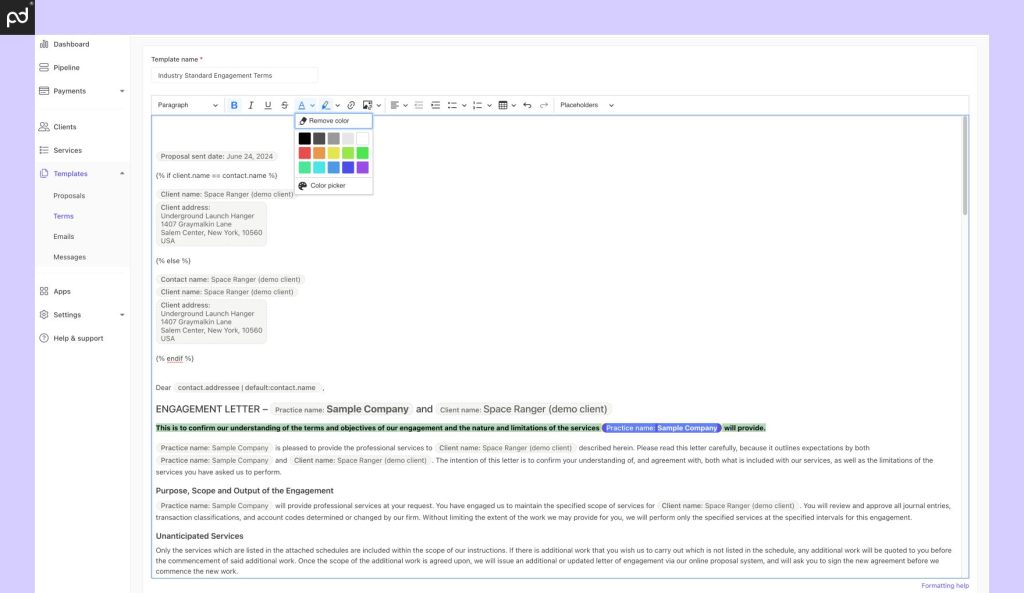
Ignition is built as a comprehensive solution for professional service businesses like accountants, consultants, and agencies.
The platform provides a suite of tools built around onboarding, engagement, and payment management so that businesses can optimize these processes and minimize their administrative workloads.
The result is a solution that gives service businesses a more holistic approach to managing client relationships beyond initial proposals.
Why are we placing such a strong emphasis on service based businesses? Because Ignition is designed specifically to accommodate businesses with recurring service solutions.
Proposals built using Ignition feature plans and packages built around recurring, monthly payments.
This means that single-charge service businesses or companies that offer physical products won’t find many options here.
These limitations are also featured in the proposal design process, which centers around the idea that teams will present a selection of package options for clients to choose from.
While some aspects of the proposal process can be modified, Ignition’s compiler is less flexible than Qwilr’s drag-and-drop solution.
Between these two tools, the deciding factor may come down to what type of business you own and what tools you need in order to round out your sales process.
10. Bidsketch
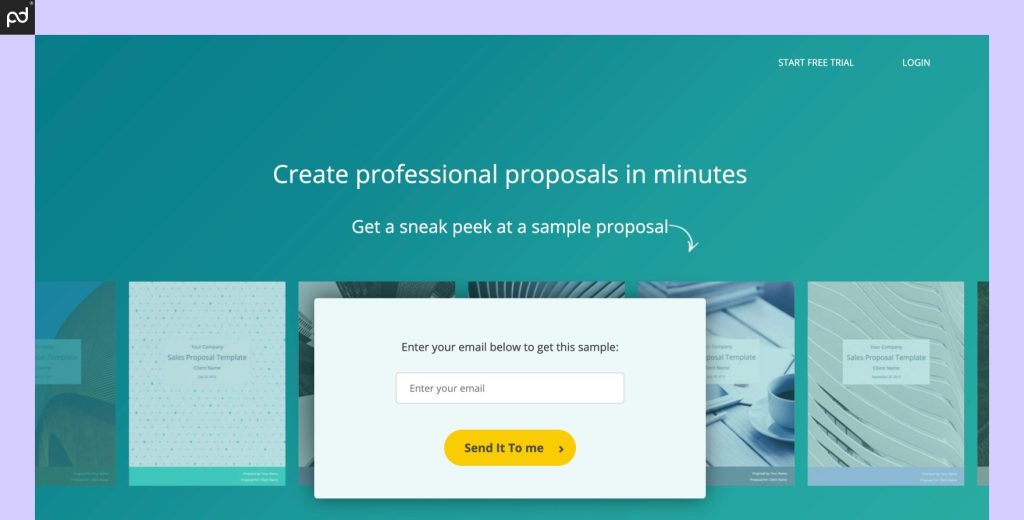
Bidsketch features simple and affordable proposal generation with a focus on speed and efficiency.
Great fit for: Freelancers and teams who want to keep proposal design time to an absolute minimum.
Rating: Bidsketch is rated 3.6 of 5 stars on G2 with 10+ ratings.
Pricing: BidSketch is charged at $15/month for Starter, $23/month for Solo Yearly, $47 month for Team Yearly, and $119/month for Business Yearly.
Free trial: Bidsketch offers a free 14-day trial.
Bidsketch is a no-nonsense proposal software designed to help freelancers and small businesses create professional proposals quickly and easily.
The platform handles all formatting, calculations, and the tedious parts of proposal creation so that teams can focus on winning new clients and expediting deals.
Bidsketch’s entire design process is different from a platform like Qwilr.
However, it’s relatively easy for beginners to use and still powerful enough to handle complex proposal creation.
Plus, with built-in e-signatures and onboard proposal tracking, teams can improve the entire sales process.
| Feature | Qwilr | Bidsketch |
|---|---|---|
| Proposal tools | Drag & drop | Compiler |
| Form generation | Limited | X |
| E-signing | ✓ | Limited |
| Templates | ✓ | ✓ |
| Content library | ✓ | Limited |
| Custom domain | ✓ | ✓ |
| Custom branding | ✓ | ✓ |
| Payment gateways | ✓ | X |
| CRM integrations | 4 | Limited |
| Document analytics | ✓ | ✓ |
| API access | $ | ✓ |
| Customer Support | ||
| Email / ticketing | ✓ | ✓ |
| 24/7 chat | $ | X |
| Phone | X | X |
| Success manager | $ | X |
| Onboarding services | $ | X |
Major differences
- Bidsketch doesn’t offer drag-and-drop proposal design like Qwilr. Instead, the platform compiles proposals from input data.
- Qwilr offers a broader selection of integration and analytics options, but Bidsketch is more budget friendly.
- Bidsketch provides a more structured and standardized design approach when compared to Qwilr.
Qwilr vs Bidsketch
While both Qwilr and Bidsketch are built around the proposal generation process, both tools handle this task in very different ways.
Qwilr offers a robust set of features for creating highly customizable proposals. Chief among these is the drag-and-drop editor.
Qwilr users will add content blocks to their proposals and then customize those blocks to taste in a live editing environment.
This is a great choice for businesses who want to adjust proposal content on the fly.
The ability to adjust proposal layouts can be a great help for organizations who rely on their proposal processes as a primary means to stand out from the crowd, particularly when combined with Qwilr’s branding tools and web page layout.
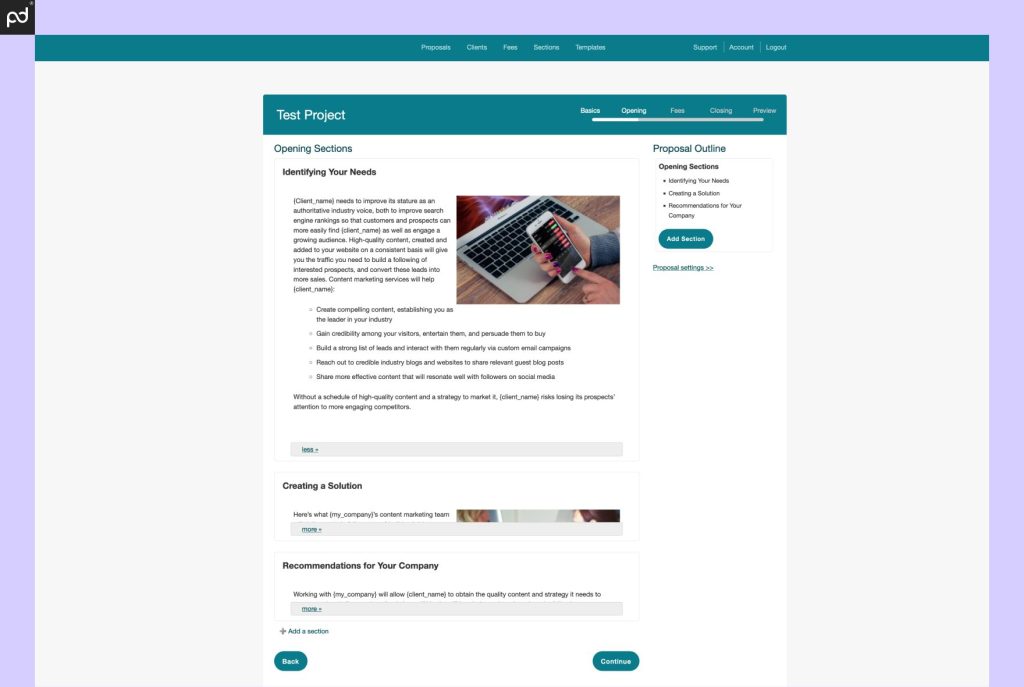
On the other hand, Bidsketch prioritizes speed and simplicity at the cost of uniqueness.
A large part of this comes down to how the proposals themselves are built.
Rather than working in a live environment, Bidsketch proposals are divided into three sections: Opening, Fees, and Closing.
Users will create blocks in the Bidsketch content library prior to generating a proposal and then simply add these blocks into the proposal layout when it’s time to generate a document.
The Bidsketch engine takes those inputs, compiles them, and produces a proposal that can be sent to clients.
It’s logical, straightforward, and easy — but it’s also vastly different than what you’ll see in something platforms like Proposify, PandaDoc, or Qwilr.
However, because Bidsketch follows this approach, most proposals end up looking very similar to one another.
With that in mind, the best choice between Qwilr and Bidsketch is likely to come down to what you value most in proposal creation.
If you prioritize customization, visual appeal, and interactive elements, Qwilr is a great option. But if you need a simple, affordable tool that helps you create proposals quickly and easily, Bidsketch might be a better fit.
Choosing the best Qwilr competitors
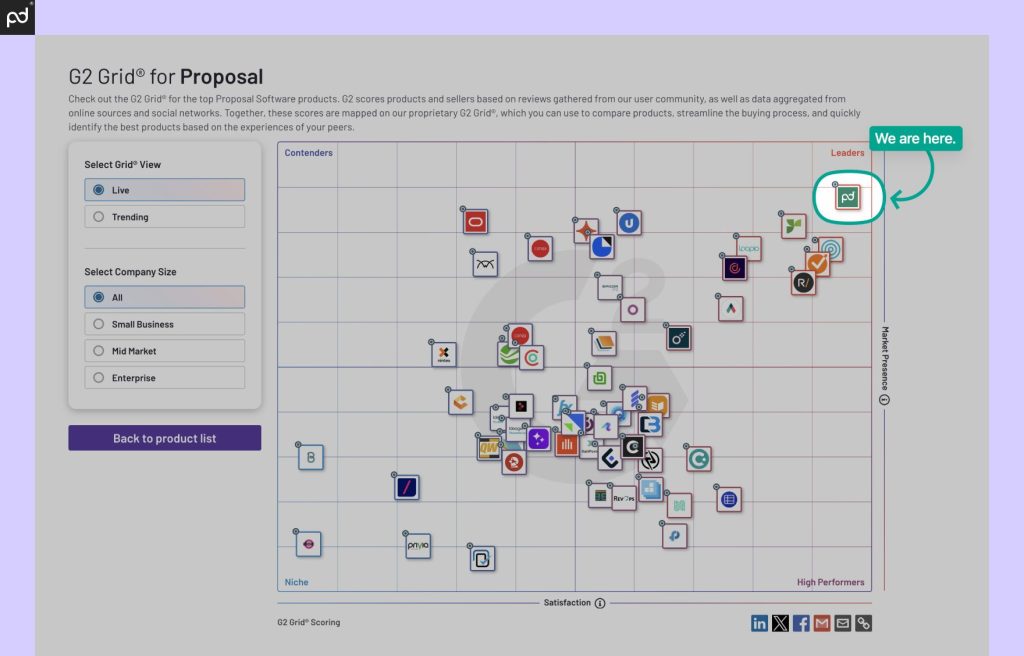
To find the best alternatives to Qwilr, we used the G2 Grid, a popular tool for comparing software based on real user feedback and market presence.
We focused on “Proposal Software” and filtered the results to match our specific needs.
By looking at user reviews, satisfaction ratings, and how well-known each option is, we identified the top contenders.
We then took a closer look at each of these alternatives, carefully comparing their strengths and weaknesses to see which Qwilr alternatives seemed most viable.
This thorough process helped us uncover the most promising Qwilr alternatives available, all based on the experiences of other users on the G2 platform.

Build better proposals with PandaDoc
Creating impactful proposals is crucial for closing deals and boosting your bottom line.
PandaDoc empowers your team to craft polished, professional documents that impress clients and drive results.
Our user-friendly platform optimizes the entire document creation process, from conception to completion, so you can focus on what matters most – winning business.
Here’s how PandaDoc can elevate your document game:
- Intuitive document editor. Effortlessly create polished, professional documents with our drag-and-drop editor and a wide array of customizable templates. No design skills required!
- Seamless collaboration. Work together with your team in real time, making it easy to gather feedback and ensure everyone’s on the same page.
- Faster approvals. Say goodbye to endless email chains and get approvals faster with automated workflows and e-signatures.
- Powerful integrations. Connect PandaDoc to your CRM, payment gateways, and other essential tools for a seamless, unified workflow.
Don’t settle for ordinary documents.
Discover the PandaDoc difference and take your document creation to the next level.
Sign up for a free 14-day trial or a personalized demo today and experience the power of streamlined document creation.
Disclaimer
PandaDoc is not a law firm, or a substitute for an attorney or law firm. This page is not intended to and does not provide legal advice. Should you have legal questions on the validity of e-signatures or digital signatures and the enforceability thereof, please consult with an attorney or law firm. Use of PandaDocs services are governed by our Terms of Use and Privacy Policy.
Originally published June 15, 2022, updated August 22, 2024


